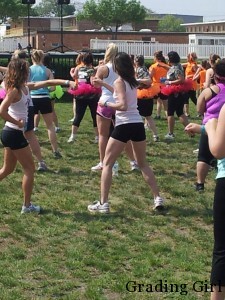Fitness for Educators
July 25, 2015 by GradingGirl
Filed under Exercise, School's Out
A teacher’s life is often misunderstood. The illusion of the workday ending mid-afternoon along with summers off is misleading. It underscores the incredible amount of time spent lesson planning, grading, answering parent phone calls and emails, attending meetings, pursuing professional development opportunities and completing coursework to update certifications. As a result, teachers often are frustrated over scheduling time for needed personal commitments as they struggle to juggle the responsibilities outside of the classroom. Coaching and extra-curricular responsibilities often take precedence too. Add a traditional food services menu still offered in schools (high carbs, processed food, sugary drinks, etc) that most would define as less than healthful, and one can see how it can be hard for teachers to stay physically fit.
Teachers like to set positive examples for their students, and we teach the student much more than we teach the content. There can be, however, many roadblocks to teachers’ personal goals, and it’s unfortunate that fitness can easily take a backseat.
As a high school English teacher myself for the past seventeen years, I completely empathize with and understand frustrations. As a fitness enthusiast for most of my life, I’ve utilized tried and true tricks to stay in-shape even during the most stressful days of the school year.
While everyone is different, and there are a variety of specific nutritional plans and exercises that will work well for specific people, here’s a general list of simple practices anyone can incorporate into his or her daily life to promote more healthful living:
Teacher Tips for Being Fit ~
1. Schedule time for exercise. Teachers love to plan ahead and work by schedules so why not write your workouts within your weekly schedule. Scheduling 30 minutes of exercise in for three – four days a week is a good goal.
Before School Option:
Wake up a half hour – one hour early to give yourself time for a morning workout. Whether it’s spending time on basic at-home movement (such as crunches, push ups, bodyweight squats or simple stretches), partaking in a morning jog or visiting the local gym, you will be more wide awake and ready to take on whatever unfolds during the day. Also, getting up before the rest of your household might help squeeze your own needed time in.During School Option:
If there is a gym facility available for faculty during the day, why not use your free period in the middle of the day for some movement? I know some colleagues who are completely refreshed after doing so and, thereby, combat the afternoon slump we may be susceptible to.After School Option:
Go to the gym directly after you leave the building or go after dinner. I personally like to get my grading done before I go to the gym so that my mind is free but there’s something to be said for going directly to the gym right after you leave the building – you will get your workout over and leave your evening free for family time and any grading you may have.2. Join a gym. This is one item in your budget that will be well spent. There are many gyms with various types of packages offered for single or family members, such as Life Time Fitness or XSport.
3. If joining a gym is not an option, exercise at home. There are many body weight routines available online. If you can push yourself through some crunches, push-ups, squats and toe raises at home, you’re off to a great habit. For a comprehensive compilation of home exercises in one convenient place, check out the world’s largest interactive list of over 200 calisthenics exercises HERE at Man vs. Weight.
4. Incorporate more movement during the school day. Take the stairs more often, go talk to colleagues across the building rather than sending emails and make an excuse to walk around the hallways or outside of the building during a free hour. I see some staff members partaking in regular walks every day during their lunch hour. Movement encourages thought, and this can be a great way to problem-solve or generate new ideas. If you really want some motivation, invest in an activity tracker such as a Fitbit.
5. Plan grocery shopping and prepare as many meals as you can over the weekend. I never have time during the week to ponder over meal plans so this is key to keeping me on track with healthful eating. Chances are your grab-and-go meals are going to be much more unhealthful than your planned ones. I peruse favorite magazines or sites such as Clean Eating for healthy recipe ideas, write down ingredients I don’t have at home and take my list to the grocery store.
6. Consume caffeine earlier in the day before noon. There are many benefits to drinking coffee but doing so earlier in the day will help you fall asleep more soundly.
7. Get regular sleep – this one may be the toughest! You may think you are doing your students a favor by finishing that grading in one particular night but you will undoubtedly do a more thorough job as a wide-awake individual. Studies show this is true.
8. Drink water throughout the day. Stay hydrated. Perhaps keep a thermos at your desk. Yes, we live by the bell but, hey, if you have to run to the restroom in-between periods, that’s another opportunity for movement!
The very infrastructure of a teacher’s day does not cater to our health needs so it’s important that we’re cognizant of all we can do to remedy our time management and stress levels.
Try some of the steps above and you will have more energy for life both in and out of the classroom. Moreover, you will be setting a better example for your students, and will feel more positive about yourself and your life in general.



